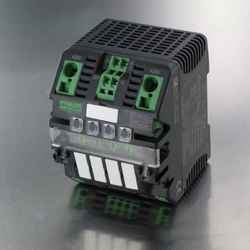
Posted to News on 21st May 2015, 13:28
Energy efficient machines - a practical point of view
Pressure is being put on to machine builders and operators by regional and national governments to increase the energy efficiency of machines and systems. This is a huge challenge for our industry. On the one hand this is forcing manufacturers to investigate ways to increase the throughput of machines thus reducing the energy required to produce each unit. On the other hand, ways need to be found to increase the overall energy efficiency of the machine in total. This can offer the machine end users a competitive advantage as it can increase process optimisation. For the machine builder, however, it can mean time-consuming analysis and implementation. Graham Traill, System Consultant at Murrelektronik, takes a closer look at energy efficiency and how small changes can have a big effect for operators and machine builders.

When thinking of energy efficiency, the first thing that comes to mind is: lower energy costs, increased efficiency and CO2 reduction. Cutting the ever-increasing energy costs is surely the primary motivation of a manufacturing company for using energy efficient machines.
Graham says: "Energy efficiency is a cutting-edge topic. The time of power guzzlers is over. "Green competence' is required in machines and systems. By looking at the control system as a whole rather than a series of components, a number of simple but effective modifications can be made that contribute to energy efficiency and the overall results are surprising."
In every automation system the power supply system is the core of the control cabinet. It consists of a power supply, output circuit/s protection and distribution. There are switch mode power supplies available that are 95 per cent energy efficient for example the Emparro range. Emparro is a new, high-efficiency power supply unit, available with output voltages of 12V / 24V / 48V and currents of 5-20A. Typically an Emparro 3 phase PSU is 30 per cent smaller than its conventional counterpart. As an example, the 20A variant is only 65mm wide. High efficiency also means that substantially less heat is dissipated in the control panel. All this beneficially affects the control panel design. Low heat dissipation means less thermal stress on all the control panel components increasing their life span and reducing maintenance costs. Panels can be made smaller with a reduced requirement for mechanical cooling thus lowering the capital cost of the panel and the valuable production space needed for it to stand. This means a reduction in the total cost for the machine builder and lower maintenance costs for the end user.
Power boost and hyper boost
Emparro power supplies feature two boost functions: power boost and hyper boost. The power boost supplies 50 per cent additional power for up to 5s whist the hyper boost provides up to 400 per cent more power for up to 20ms. This means that devices requiring high input currents on start up can be supplied from a PSU sized to cater for the system running current rather than resorting to a larger power supply, again saving panel space and system costs. High efficiency also means that the Emparro can operate at 20 per cent overload in ambient temperatures of up to 45degC. This allows for a continuous supply of 6A for 5A models, 12A for 10A models and 24A for 20A models. This feature is claimed to be unique in the market.
When reflecting upon energy in automation technology, often only the major key elements are taken into account such as power supply units, drive controls and motors. But who, so far, has thought about energy efficiency when it comes to the protection and distribution of 24V DC circuits?
For example, consider a typical application consisting of a power supply with circuit breakers (MCB) for secondary circuit protection. MCBs require an unnecessarily large amount of energy due to the high resistance within the circuit breaker. When compared with the MICO range of electronic circuit protection, the internal resistance of an MCB can be up to 40 times higher, depending on the current range. This means that energy consumption is higher with MCBs due to losses in the form of heat.
Circuit breakers in 24V DC/48V DC systems can only offer very limited protection or, worse still, no protection at all. For example, they do not work with cable cross-sections below 0.75mm ² and currents below 10A. Anyone wishing to protect against short circuits and overloads and improve their system's energy efficiency should switch to MICO electronic circuit protection.
A special energy-efficiency feature has been designed in to the advanced MICO+ circuit protection modules. MICO+ offers a stand-by function. This feature allows for circuits not required continuously to be deactivated when not in use via a 24V DC input and immediately switched on when required, while important components are continuously supplied by the same module.
In the end it is often a culmination of small things that are not most obvious that brings the biggest savings. As they say "the devil is in the detail'.
Finally, it is worth mentioning that the benefits of this power supply concept can be realised in existing systems as size does not exclude retrofitting in to an existing control panel.
To learn more about the possibilities for the energy efficiency of machines and systems, please visit www.murrelektronik.com.
5 Albion Street, Pendlebury Industrial Estate
Swinton
M27 4FG
UNITED KINGDOM
+44 (0)161 728 3133






























